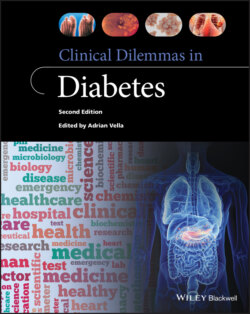Читать книгу Clinical Dilemmas in Diabetes - Группа авторов - Страница 20
Risk of progression from prediabetes to diabetes mellitus
ОглавлениеThe transition from prediabetes to DM2 is variable and influenced by heredity and lifestyle [18, 19, 43]. Multiple variables have been used to estimate the risk of progression to DM2, including glycemic indices, anthropometric data, comorbidities, metabolomics, and genetic variants. Numerous prediction models have been created based on these variables [43–51].
Baseline FPG is a significant predictor of an individual's risk for developing DM [43]. In nondiabetic adults residing in Minnesota, baseline FPG levels < 100 mg/dL, 100–109 mg/dL, and 110–125 mg/dL were associated with a 7%, 19%, and 39% risk, respectively, with progression to DM over a median of 9 years. A discrete gradient of risk for progression to DM was also observed among subjects with a baseline FPG < 100 mg/dL.
During a 75‐g OGTT, 30‐minute, 60‐minute, and 120‐minute PG concentrations were all significant predictors for future risk of DM [49, 52]. One‐hour plasma glucose during a 75‐g OGTT has been shown to be a better predictor of future DM than FPG, HbA1c, and PG at 30 minute and 120 minutes during a 75‐g OGTT [50]. In one study, the hazard ratio for the development of DM was 9.5 (7.90–11.43) for those with combined IFG‐IGT at baseline, 4.5 (4.03–5.02) for those with isolated IGT at baseline, and 3.98 (3.16–5.02) for those with isolated IFG at baseline [45].
Baseline HbA1c is also a strong predictor for risk of future DM, and the risk of incident DM significantly increased across the HbA1c range of 5.0–6.5% [46]. A systematic review found that the 5‐year incidence of DM was 25–50%, 9–25%, and 5–9% among those with a baseline HbA1c of 6.0–6.5%, 5.5–6.0%, and 5.0–5.5%, respectively.
Numerous studies have shown that demographic data, anthropometric data, and comorbidities are associated with progression to DM. Factors positively associated with progression to DM include: family history of diabetes, former or active smoking, higher BMI, abdominal obesity, increased waist circumference, hypertension, elevated triglycerides, low HDL cholesterol, and elevated high sensitivity C‐reactive protein [45, 53, 54]. Increasing age has also been shown to be a predictor of DM in some studies.
Metabolomics profiles have been investigated as a tool to estimate the risk of developing DM. Numerous metabolites have been found to be positively and negatively associated with progression to DM [51]. More than 400 distinct genetic signals that affect the risk of developing DM2 have been identified [20, 44]. Polygenic scores have been used to estimate the combined genetic risk for the development of DM.
